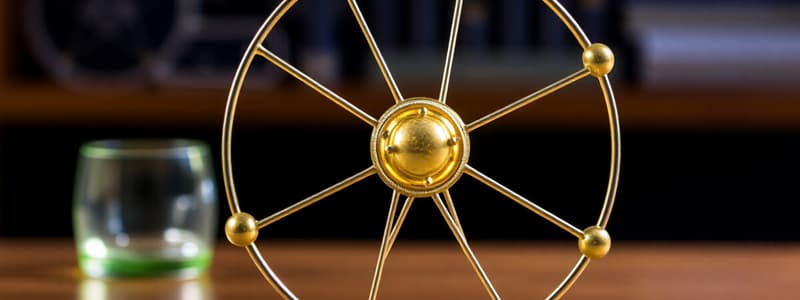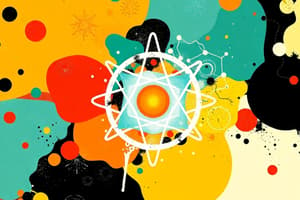Podcast
Questions and Answers
What is a characteristic of objects in scientific context?
What is a characteristic of objects in scientific context?
- They are always larger than referents.
- They can be seen or touched. (correct)
- They are always measured in pounds.
- They are defined by their color only.
What is one of the steps involved in quantifying properties through measurement?
What is one of the steps involved in quantifying properties through measurement?
- Assigning random numbers to properties.
- Using qualitative descriptors to define the property.
- Comparing the referent unit to the property being described. (correct)
- Ignoring standard units when recording results.
Which of the following is NOT a base unit in the Metric (SI) system?
Which of the following is NOT a base unit in the Metric (SI) system?
- Mole (mol)
- Meter (m)
- Kilogram (kg)
- Pound (lb) (correct)
What does the procedure of measuring with a paper clip involve?
What does the procedure of measuring with a paper clip involve?
What is one challenge mentioned with the language used in science?
What is one challenge mentioned with the language used in science?
Which of the following represents a unit of length in the metric system?
Which of the following represents a unit of length in the metric system?
What is the metric prefix that indicates a factor of $10^{3}$?
What is the metric prefix that indicates a factor of $10^{3}$?
The density ratio is defined as the ratio of which two properties?
The density ratio is defined as the ratio of which two properties?
In the context of significant figures, which statement is generally incorrect?
In the context of significant figures, which statement is generally incorrect?
What unit symbol corresponds to the metric unit for electric current?
What unit symbol corresponds to the metric unit for electric current?
Which metric prefix indicates a factor of $10^{-6}$?
Which metric prefix indicates a factor of $10^{-6}$?
In terms of proportionality, which of the following describes a direct proportionality?
In terms of proportionality, which of the following describes a direct proportionality?
Which unit is equivalent to a temperature measurement in the metric system?
Which unit is equivalent to a temperature measurement in the metric system?
What is the boiling point of mustard gas in Fahrenheit?
What is the boiling point of mustard gas in Fahrenheit?
How many degrees Fahrenheit is equivalent to a temperature of 38.7 °C?
How many degrees Fahrenheit is equivalent to a temperature of 38.7 °C?
What is the formula to convert Celsius to Kelvin?
What is the formula to convert Celsius to Kelvin?
What is the normal body temperature in Celsius?
What is the normal body temperature in Celsius?
Using the conversion factor, how many kilometers are there in 26.22 miles?
Using the conversion factor, how many kilometers are there in 26.22 miles?
What is the definition of a conversion factor?
What is the definition of a conversion factor?
Which step is NOT part of the problem-solving method for unit conversions?
Which step is NOT part of the problem-solving method for unit conversions?
What is the first step in the scientific method?
What is the first step in the scientific method?
What is a hypothesis in scientific research?
What is a hypothesis in scientific research?
What distinguishes a controlled experiment from other types of experiments?
What distinguishes a controlled experiment from other types of experiments?
What is the main difference between laws, models, and theories in science?
What is the main difference between laws, models, and theories in science?
How do scientists communicate experiment results?
How do scientists communicate experiment results?
Which of the following best defines pseudoscience?
Which of the following best defines pseudoscience?
What is the purpose of modifying an explanation in the scientific method?
What is the purpose of modifying an explanation in the scientific method?
What role do patterns in experiment results play in science?
What role do patterns in experiment results play in science?
What is the significance of having someone's claims validated by peers in science?
What is the significance of having someone's claims validated by peers in science?
Study Notes
The Nature of Science
- Science emerged approximately 300 years ago, associated with Galileo and Newton.
- It involves experimental evidence, a key difference from the "thinking only" approach of Ancient natural philosophers.
The Scientific Method
- The scientific method is a cyclical process that involves:
- Observing some aspect of nature.
- Proposing an explanation for the observation.
- Using the explanation to make predictions.
- Testing the predictions through experiments or more observations.
- Modifying the explanation as needed.
- The cycle repeats from step 3.
The Scientific Method - Example
- An example of the scientific method is the discovery of the atomic structure:
- The initial assumption was that atoms were made of negative electrons orbiting positive nuclei.
- Experiments involving colliding two atoms resulted in free electrons and nuclei being produced.
- This led to the understanding that atoms are made of electrons orbiting nuclei made of protons and neutrons.
- Further research involved colliding atoms at higher energies to gain deeper insights.
General Scientific Activities
- Science involves collecting observations, developing explanations, and testing those explanations.
Explanations and Investigations
- A hypothesis is a tentative explanation for an observation.
- An experiment is a recreation of an event or occurrence to test a hypothesis.
- A controlled experiment compares two situations, keeping all factors alike except one.
- The control group remains fixed for comparison.
- The experimental group differs from the control group by one influencing factor.
- Scientific communication plays a crucial role in sharing patterns and experiment results.
Laws, Models, and Theories
- Laws describe important relationships observed repeatedly:
- Example: Charles's Law, which describes the relationship between temperature and pressure in gases.
- Models represent a theory or idea that explains all known properties:
- They can be physical, mathematical, based on a sketch, or an analogy.
- Models are useful for phenomena too small or too vast for direct observation.
- Theories represent a broadly based set of working hypotheses:
- They are supported by considerable experimental evidence.
- Theories form the framework for scientific thought and experiments.
Pseudoscience
- Pseudoscience refers to misleading and often absurd claims disguised as scientific results.
- To identify pseudoscience, consider:
- The claimant's academic and scientific background.
- Peer review history.
- Participation in scientific institutions and organizations.
- Publication in peer-reviewed journals and independent validation.
- Whether the claimant has something to gain from the claim.
Studying That Suits You
Use AI to generate personalized quizzes and flashcards to suit your learning preferences.
Related Documents
Description
This quiz explores the nature of science and the scientific method, highlighting its historical emergence and practical phases. By engaging with examples, learners will understand how scientists develop and test explanations based on observations. Get ready to test your knowledge on these essential concepts!



